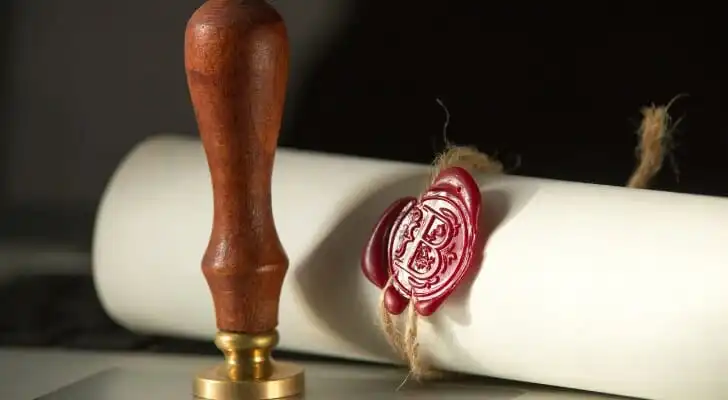 When trusts are used as estate planning tools, financial institutions such as banks and brokerages may require written documentation of the trust’s existence before transferring assets into a trust or naming it as a beneficiary. However, they don’t need to see all the details of the trust, such as identities of the beneficiaries. When financial institutions need trust documentation, a signed and notarized certificate of trust can fulfill this requirement while keeping other information about the trust private.
When trusts are used as estate planning tools, financial institutions such as banks and brokerages may require written documentation of the trust’s existence before transferring assets into a trust or naming it as a beneficiary. However, they don’t need to see all the details of the trust, such as identities of the beneficiaries. When financial institutions need trust documentation, a signed and notarized certificate of trust can fulfill this requirement while keeping other information about the trust private.
A financial advisor can analyze your estate planning needs, including what documents you need. Find a financial advisor today.
The certificate of trust’s primary job is to attest that the trustor actually has control of the assets being placed in the trust. The certificate of trust is a legal document that may also be called a trust certificate, memorandum of trust or abstract of trust.
The trust certificate can be considered an outline or summary of the primary documents describing the trust. Trust documents can be complex and lengthy, more than 100 pages in some cases. The trust certificate is preferred as a concise and convenient way to give financial institutions the information they need while omitting the unnecessary details.
Filing a certificate of trust is often a one-time event. However, sometimes you may need to update a certificate of trust. This could be the case if the trust sells or acquires any real property. If a trustee dies, the trust certificate will need updating. If the trust has been altered since it was created, the trust certificate will provide the date the changes were made.
Trust Certificate Contents
There is no standard universal certificate of trust document or format. Most states have their own statutes describing the requirements for a valid trust certificate. However, generally, a certificate of trust will contain the following information:
- Name of the trust
- Name and address of the person creating the trust, known as the trustor, grantor or settlor. If more than one person, such as a married couple, are creating the trust, they should both be identified.
- Identity and specific powers of the trustee
- Date the trust was created
- Legal description of any real estate included in the trust
- Whether the trust is irrevocable or revocable
- If revocable, who is able to revoke it
- The trust’s tax identification number
- Signatures of the trustors, including both members of a married couple
- A stamp and signature of a notary
Depending on the state, the certificate may also have to have other information. These added details may include copies of the first and last pages of the complete trust document, references to the statutes under which the trust is being set up and other details.
Acquiring a Certificate of Trust

A financial institution will accept a complete copy of the trust documents in place of a certificate of trust. However, if the trustor wants to keep any details of the trust private, he or she will need to acquire a certificate of trust. Since there is no standard certificate of trust form, each certificate of trust may be somewhat different. A trustor can draft his or her own certificate of trust. A do-it-yourself certificate of trust needs to include the information that is required in the state where the trust is created. It also has to include the required signatures of the trustor and the notary.
Alternatively, here are other sources for a certificate of trust:
- The bank, brokerage, escrow company or other financial institution likely has a trust certificate form you can fill out and use.
- An estate lawyer or other attorney can help draft a certificate of trust. This includes online legal and estate planning services.
- Online legal document sources contain sample forms, although these may differ by state.
- A notary public may also have a copy of a state-specific form you can use.
Once the certificate of trust has been created and completed using the required information, it must be signed by all the trustees. The signatures have to take place in the presence of a notary. Then the notary has to stamp the form and sign it, attesting that the signatures were witnessed.
Finally, the certificate of trust may need to be recorded with the local county trust office. Recording is essential if the trust contains any real estate.
Bottom Line

A certificate of trust is a brief summary of a trust that is being used for estate planning. Financial institutions such as various types of banks or brokerages require certificates of trust to document that a trust exists and identify the trustor and trustee. A certificate of trust also gives the name of the trust, date it was set up and any real property it contains, among other details. Requirements for certificates of trust vary by state. Most financial institutions have certificates of trust their customers can use to fulfill state requirements. Certificates of trust have to be signed and notarized and may be recorded as the county trust office.
Tips on Estate Planning
- A trust can be a powerful tool for estate planning. Effectively using a trust to manage estate taxes and avoid probate is easier with the assistance of an experienced and qualified financial advisor. SmartAsset’s free tool matches you with financial advisors in your area in five minutes. If you’re ready to be matched with local advisors who will help you achieve your financial goals, get started now.
- While a certificate of trust can be a useful estate planning tool, it’s not the only one you may need. You may also need to set up a will, advance healthcare directive or power of attorney to protect your assets. Life insurance, disability insurance and longterm care insurance are also things to consider including in your estate plan to ensure that you’re able to pass on as much of your estate as possible to future generations.
Photo credit: ©iStock.com/Ilya Burdun, ©iStock.com/GCShutter, ©iStock.com/hapecharge